Who built it: Harihara and Bukkaraya
Where is it located: On the banks of Tungabhadra River in the Northern part of Karnataka, India
Visit Timing: Sunrise to Sunset
Entry Fee per Person: For Vitthala Temple Complex and Zanana Enclosure –Rs. 30/- for Indian citizens and visitors of SAARC and BIMSTEC countries; Rs. 500/- for other foreign nationals; free entry for children up to 15 years.
How to Reach: While the nearest airport and railhead to Hampi are Ballari (64 km) and Hosapete (10 km) respectively; this ancient village is well-connected by road with several South Indian cities including Mysore and Bengaluru.
Hampi a village located on the banks of the Tungabhadra River is regarded as one of the most important world heritage sites in India. It was counted amongst the largest and most prosperous cities of the world during its period of power and vigour. This site that holds significance both historically and architecturally has several monuments, particularly the Virupaksha Temple that is dedicated to the patron deity of the Vijayanagara rulers, Lord Virupaksha, which is why it is often referred as Virupakshapura and Vijayanagara. Traces of grandeur and culture of this lost city of Asia that lie within the Vijayanagara city, which remained capital of the Vijayanagara Empire, is reflected from the remains of the city that include temples, masjid, civil and military buildings among others. Recognised as a UNESCO World Heritage Site (Group of Monuments at Hampi), this site has emerged as one of the most visited historical destinations by tourists.
History of Hampi
According to rock edicts of Emperor Ashoka in Udegolan and Nittur, during the 3rd century BC, this site remained under the jurisdiction of the Maurya Empire. It saw its first settlements in 1CE. Hampi remained an integral part of the capital city of the Vijayanagara from 1343 to 1565 - being located in a strategically favourable position with the abounding Tungabhadra River flowing on one side and hilly terrains surrounding the other three. The powerful Vijayanagara Empire had two million men in its army and during 1500 AD the capital city had an impressive 500,000 inhabitants that came to around 0.1% of the worldwide population between 1440-1540, thus positioning it globally as the second largest city after Beijing. While the conventional names of the place included ‘Bhaskara-kshetra’, ‘Kishkindha-kshetra’ and ‘Pampa-kshetra’, it derived the name Hampe from the old name of the ‘Tungabhadra River’, ‘Pampa’. ‘Hampe’, the Kannada name was later anglicized as Hampi.
The Deccan Muslim confederacy conquered the city in 1565. It was plundered for more than six months following which it was abandoned. The yesteryear splendour of the place including the royal, cultural and religious systems is manifested from the remains that comprise of around 1600 structures encompassing royal buildings, temples, mandapas, shrines, pillared halls, stables, defence check posts, water structures and gateways among others. These remains speak volumes of the socio-economic and political developments of Hampi.
In 1800 Colin Mackenzie discovered the remains of Hampi. Over the years the Archaeological Survey of India (ASI) has been conducting excavation works in the site. Archaeologists opine that the ‘Islamic Quarter’, also referred as the ‘Moorish Quarter’ built amidst the Talarigatta Gate and the northern slope of the Malyavanta hill were used for residential purpose by the top ranking Muslim officers and military officers of the king.
Some of the Notable Structures at Hampi
Virupaksha Temple
The Virupaksha Temple also called the ‘Pampavathi Temple’ located in Hampi Bazaar is one of the earliest monuments of Hampi even preceding the foundation of the Vijayanagara Empire. Originally a small shrine, it was later developed into an imposing and rich temple during the Vijayanagara Empire. Dedicated to Lord Virupaksha, the patron deity of the Vijayanagara rulers, this temple has three entrance towers or gopuras with the main entrance tower being the highest measuring 49 m, a second entrance tower comparatively smaller leading to inner courtyard of the temple. The third gopura referred as Kanakagiri gopura leads to another enclosed area that houses subsidiary shrines and finally to the Tungabhadra River. King Krishnadevaraya dedicated the mandapa and the inner gopura to the temple during his coronation in 1510 CE. Evidences found indicate the temple underwent expansions works during the Hoysala and Chalukya period. Although the 1565 war damaged the temple, it continued to remain as the central place of worship of the area. Renovation works of this 9-tiered structure measuring 50 m were also carried out during the early 19th century.
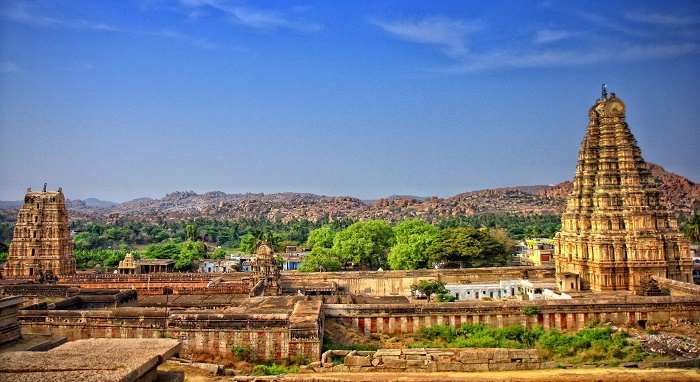
Image Credit: wordzz.com
Badavi Linga
It is the largest monolithic Linga in Hampi measuring 3 feet, dedicated to Lord Shiva. Housed within a chamber, this Linga is situated beside the Lakshmi Narasimha statue. Three eyes of the Lord are etched on the Linga. According to legends a peasant woman commissioned to build it which is why ‘Badya’ meaning poor in local language became associated with its name. A water channel is linked to the sanctum of the Linga which always remains submerged in water.
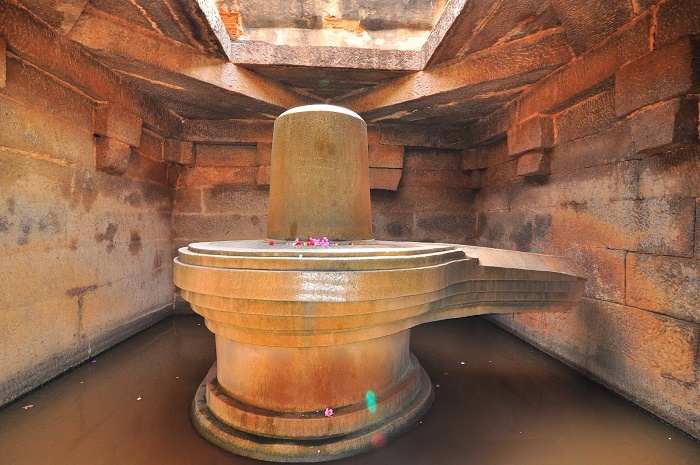
Image Credit: tourmet.com
Vittala Temple Complex
The most famous part of the site is perhaps the Vittala Temple complex that apart from housing the famous Vittala Temple also includes halls, pavilions and many other temples most notably the colossal stone chariot that has become iconic with the site and is presently used as a symbol by Karnataka Tourism. The Vittala Temple dedicated to Lord Vittala, an incarnation of Lord Vishnu, built in 15th century AD is an architectural gem that consists of wondrously created pillared halls. Remains of the Vittalapura Township that once existed around the complex are visible from the complex.

Image Credit: justaboutev3rything.blogspot.in
Ganigatti Jain temple
Hampi housed several Jain temples including the Ganigatti, Parsvanath Charan and Ratnantraykut Jain temple most of which are in ruins and devoid of idols. The remains indicate that the temples date back to the 14th century. Of these the Ganigatti Jain Temple made in the shape of a stepped pyramid with six gradually tapering storeys is one of the earliest temples of the Vijayanagara Empire. It was built by Iruguppa Da??an?yaka during the rule of king Harihara II and consecrated in 1386 AD manifested by an inscription on the column. Dedicated to the 17th Thirthankara of the Jaina faith, Kunthunatha, it is also called the Kunthunatha Jaina Temple and ‘The Oil-Woman Temple’. Built in the Vijayanagara style of architecture with some elements from temples of Chalukya era, it is adorned with different Jain sculptures and consists of an inner sanctum or the garbha griha and two halls namely the antarala ardha mantapa and the maha mantapa.
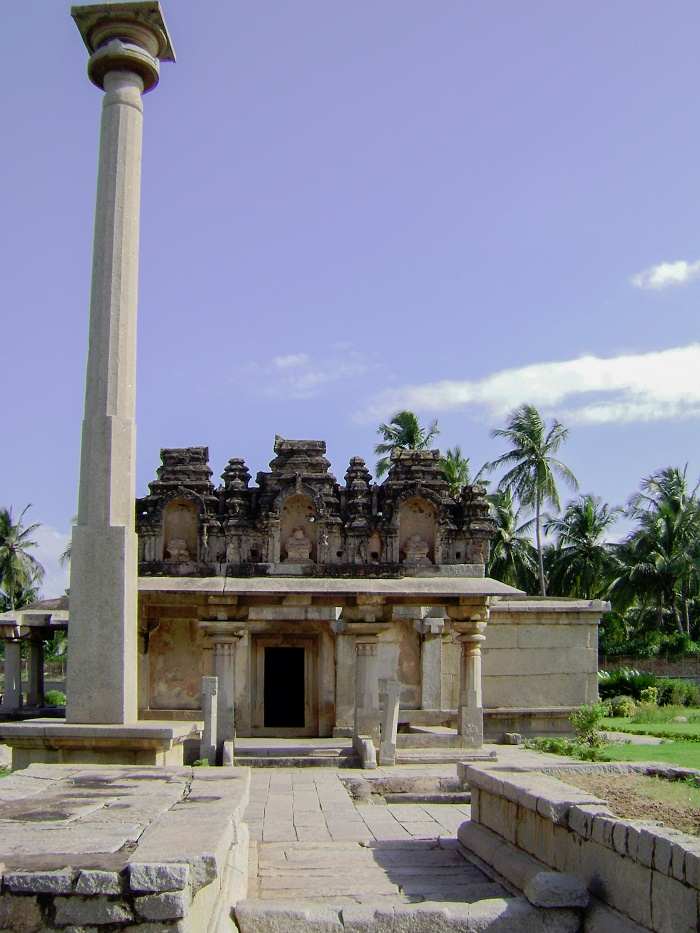
Image Credit: Dr. Murali Mohan Gurram
Krishna Temple
Krishna Temple was constructed in 1513 CE during the rule of king Krishnadevaraya to commemorate his conquest over the Gajapatis of Orissa. Abandoned during the fall of the Vijayanagara Empire, this temple continues to attract tourists for its technical marvels that include the swing pavilion and the renowned musical pillars apart from a Sacred Tank or Pushkarani. A huge slab installed in its courtyard bears and inscription about its history. The central idol of the temple, a figure of infant Lord Krishna referred as Balakrishna, now finds place in the Chennai State Museum.
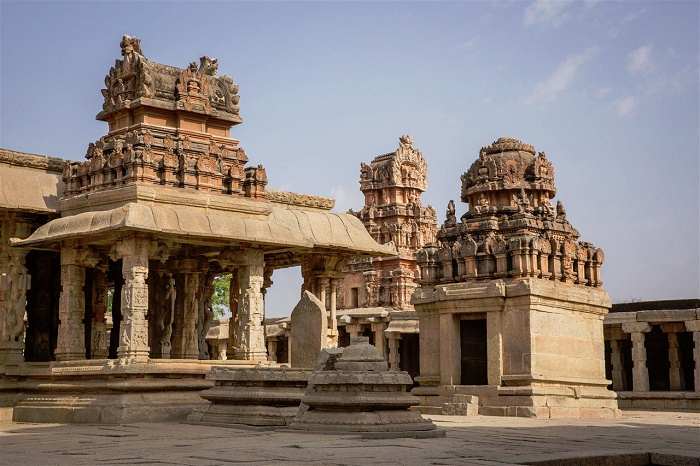
Image Credit: kevinstandagephotography.files.wordpress.com
Lotus Mahal
This Lotus-like two-storied symmetric structure also referred as the ‘Lotus Palace’, ‘Chitrangini Mahal’ and ‘Kamal Mahal’ is located in the ‘Zanana Enclosure’. The enclosure meant for the Queen and other royal ladies include private temples and servant quarters. The palace stands as one of the finest examples of Indo-Islamic architecture with the base depicting Hindu foundation of stone typifying Vijayanagara style of architecture while the upper pyramidal towers illustrate Islamic architecture
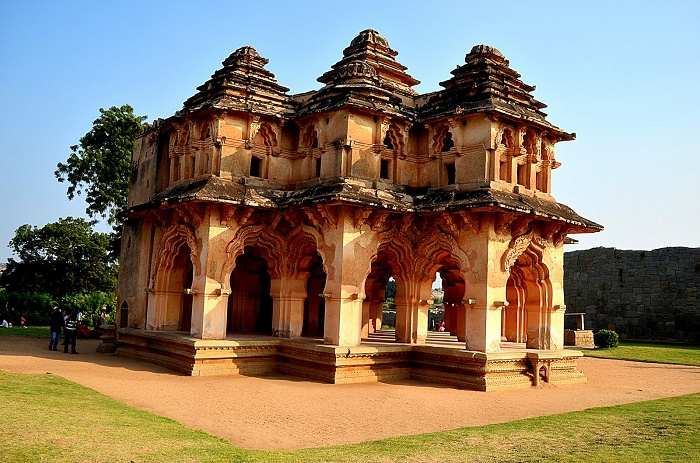
Image Credit: say2daffodil.blogspot.in
Hampi Bazaar
This bazaar also referred as the Virupaksha Bazaar is situated in front of the Virupaksha Temple at the foothill of the Matanga Hill. This place around a kilometre in length comprised of residences of the nobles as also a series of old pavilions that formed parts of the market. A gigantic figure of Nandi, mount of Lord Shiva, is installed at the eastern end of the street that also houses a platform. This platform acts as the central stage during the annual Hampi festival. Currently this area houses several shops and residences of poor villagers with a nursery school for the village children, marking it amongst the oldest nursery schools of the world.
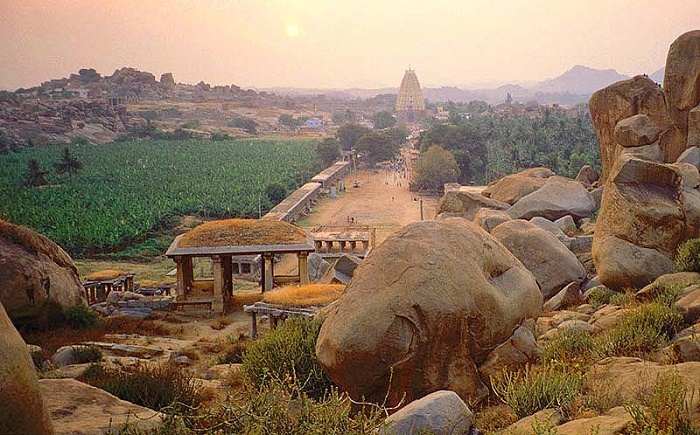
Image Credit: rontravel.com
Archaeological Museum
One of the main attractions of Hampi is the Archaeological Museum located at Kamalapura which was established by ASI. It began moving the antiques to the museum from 1972 and presently houses four galleries that display different sculptures, armoury, religious items, gold and copper coins, sati stones, brass plates among other items dating back to Vijayanagara Empire.
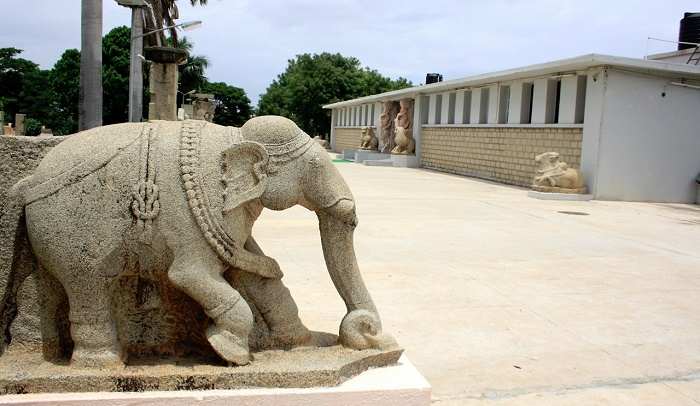
Image Credit: worthview.com



